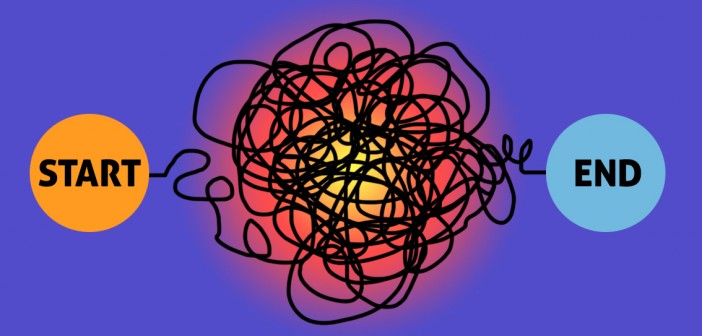Consciously or unconsciously, everyone experiences the creative process. Knowing its stages can be very helpful in boosting creativity, coming up with innovative ideas and executing them in a sustainable, smart way. Where to start the creative process? What activities are involved in a project development? How to move smoothly from an unclear vision to a project release? Let’s disenchant the creative process and enjoy a mindful, conscious creation.
Text and illustration by Joanna Wróblewska
How much do you know about creativity? Do ideas pop up in your head randomly without any previous effort? Sometimes it seems like creativity is something that just happens, but we should realize that this is actually not true. Scientists all over the world, including Jacques Hadamard and Henri Poincaré, proved that creative process is pretty complex and it is not as accidental as we tend to think.
In this article, we focus on the three most important aspects of the creative process: inspiration, execution and release. Each of them consists of minor steps that let one develop a project. Sometimes, it is necessary to move back in the process or even start it from the very scratch. It is interesting to notice that all the creative processes that we go through are both very similar and quite different at the same time. In the end, the simple scheme described below should work not only for SAE students, but also for all the other creatives.
“There are really three parts to the creative process. First there is inspiration, then there is the execution, and finally there is the release.”
— Eddie Van Halen (at BrainyQuote)
Inspiration
There is no innovation without inspiration! Gathering information, collecting images, items or music pieces is the basis of each creative process. Realize that your ideas are not that random – they are combinations of what you experienced, saw, or learned in the past. In order to generate ideas you should stimulate your brain and feed it with quality information. Be like a sponge! Go to exhibitions, concerts, talks, and discussions. Read books, surf the web, ask questions to your teachers and peers. Formulating ideas takes time and should be done carefully. Feeling inspired will make you feel both excited and engaged. This feeling of enjoyment is your green light to generating your own unique concepts.
When ready, write all the ideas down. Do not judge them yet – just put them all on paper to make space in your mind. Then take a break. Rest. Have fun. Now you can come back to your concepts and evaluate them. This step can generate a bit of confusion: which idea is the best? It is not easy to make a decision, so ask for help. You will surely have an “eureka” moment here! For verification, arrange a meeting with your tutor, get feedback from friends and family, maybe set an online survey and encourage social media acquaintances to share their answers.
Finally, pick the most promising idea and plan the realization in simple steps. Do not forget to write down a list of a few well-defined goals for your project. Setting clear objectives is extremely important and will help you to stay on the right track.
Execution
It is time to implement your idea. Nobody can promise that you will not struggle with difficulties, but recognizing fears and frustrations should make this stage much easier. Moving from a concept to a realization of a project will force you to experiment and fail. Most likely, you will move from one step to another and come back to the beginning again. It is all about testing solutions, getting feedback, improving, changing, and modifying. All this can become a problem, especially if you are a perfectionist. Some people are not flexible enough to let go and modify their concepts which leads to a great discouragement, not even mentioning a burn-out. Edison described this stage as “1% inspiration and 99% perspiration” and he was completely right. The execution of a project always costs time and effort, and there is nothing we can do about it.
Testing your idea will be a significant element of this stage, so plan enough time to do so. Are you in a process of creating a music record? Go to the booth a couple of times, test diverse options. Do you plan a photo shooting? Book a studio, check the weather forecast, find professional and reliable models. Are you designing a website? Take time to test diverse menu settings, produce high-quality images, and get feedback related to user experience. Achieving a pleasing final product will be your biggest reward. Now, you can take another break!
Release
Finally, you reached the goal – your project is finished and you are in the last stage of the creative process. Releasing a project is actually a big deal and you should take care of the presentation. Are you prepared to talk about your concept? Do you know answers to basic questions that can be thrown at you by a teacher or a client? Are you ready to defend your work? Make the release of your project a big thing. Be professional. Be proud. Be prepared. Talk about your creative process, give reasonable arguments and listen to feedback. This is the hard part but always remember that people should judge only your work, not you. Take this feedback with calm and confidence, and improve.
Learn more:
Creative Process Illustrated
Creative Process in 5 Stages
A choreographer’s Creative Process in Real Time

